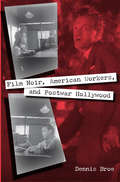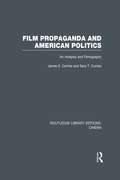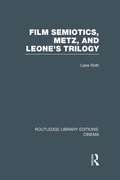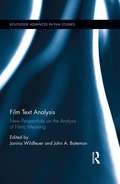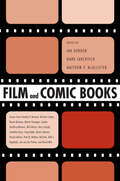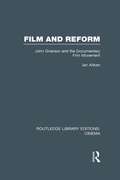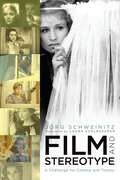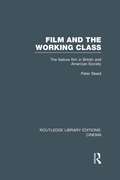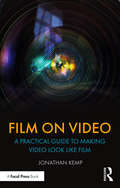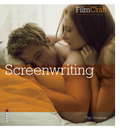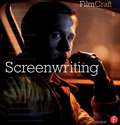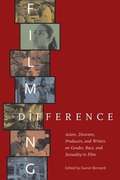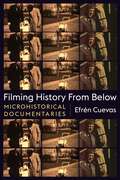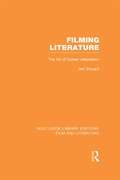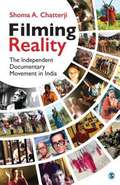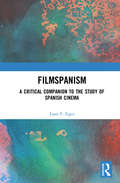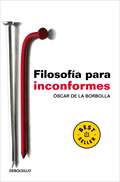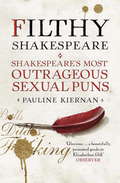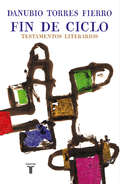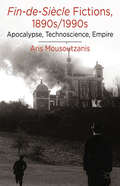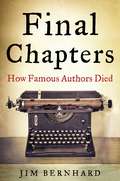- Table View
- List View
Film Literacy im Englischunterricht: Eine Mixed Methods-Studie zur Erhebung der Kompetenzen von Lernenden der Sekundarstufe I (Literatur-, Kultur- und Sprachvermittlung: LiKuS)
by Jan-Erik LeonhardtFilme sind zu einem wichtigen Bestandteil des Fremdsprachenunterrichts geworden, jedoch erfolgte der Einsatz von Filmen bislang auf Basis eines empirisch wenig fundierten Forschungsfeldes. In diesem Buch untersucht Jan-Erik Leonhardt die Frage, welche Teilkompetenzniveaus von Film Literacy, also der Fähigkeit zu einem kritischen und selbstbestimmten Umgang mit Filmen, Lernende der Jahrgangsstufen 6, 8 und 10 in der Fremdsprache Englisch erreichen. Die Studie ist nach einem Mixed Methods-Design aufgebaut, bei welchem die Ergebnisse eines Fragebogens (n=771) und eines Kompetenztest (n=626) durch die Ergebnisse von Gruppeninterviews (n=36) validiert, ergänzt und erweitert werden. Die zentralen Ergebnisse der Arbeit umfassen eine datenbasierte Neumodellierung des Konstrukts Film Literacy. Auf Basis der Erhebung werden differenzierte Aussagen über die Film Literacy der Lernenden getroffen und Prädiktoren identifiziert, welche ihre Film Literacy voraussagen. Anhand der Studienergebnisse leitet der Autor abschließend evidenzbasierte Prinzipien für die Planung und Durchführung filmbasierten Fremdsprachenunterrichts ab.
Film Noir, American Workers, and Postwar Hollywood: Film Noir, American Workers, And Postwar Hollywood (Working in the Americas)
by Dennis BroeFilm noir, which flourished in 1940s and 50s, reflected the struggles and sentiments of postwar America. Dennis Broe contends that the genre, with its emphasis on dark subject matter, paralleled the class conflict in labor and union movements that dominated the period.By following the evolution of film noir during the years following World War II, Broe illustrates how the noir figure represents labor as a whole. In the 1940s, both radicalized union members and protagonists of noir films were hunted and pursued by the law. Later, as labor unions achieve broad acceptance and respectability, the central noir figure shifts from fugitive criminal to law-abiding cop.Expanding his investigation into the Cold War and post-9/11 America, Broe extends his analysis of the ways film noir is intimately connected to labor history. A brilliant, interdisciplinary examination, this is a work that will appeal to a broad spectrum of readers.
Film Propaganda and American Politics: An Analysis and Filmography (Routledge Library Editions: Cinema #Vol. 4)
by James Combs Sara T. CombsOriginally published in 1994, this important book traces the rise of film propaganda in the 20th Century, discussing specifically how film can be used to manipulate public perception and opinions. Two distinct areas are covered: war propaganda, including feature and documentary films regarding warfare; and civilian propaganda, including films that address a variety of political subjects. Although the focus is American film and American politics, this book offers insights for all those interested in the affect of film on the minds of citizens of any country or state.
Film School: A Practical Guide to an Impractical Decision
by Jason B. KohlDevelop the tools you will need to succeed before, during, and after your film school education. Film School: A Practical Guide to an Impractical Decision is a specific, straightforward guide to applying, getting into, and thriving in film school and in the industry in general. Not only does this book appeal to both prospective and current film students, it also features an in depth discussion of the application process, both from the graduate and undergraduate perspectives. You will learn how to choose between different schools and programs, avoid debt, succeed at festivals, and transition out of film school and into the work world. Author Jason Kohl offers: Tips on how to develop your voice before attending film school A chronological layout that allows you to continually refer to the book throughout your film school process Advice on how to gauge the cost of attending film school Whether you are a recent film school graduate, or just starting the application process, Film School gives important advice and insider knowledge that will help you learn and grow in the film industry. Film School is a must-have for anyone who wants to know what it takes to succeed in film school and beyond.
Film School: A Practical Guide to an Impractical Decision
by Jason B. KohlDevelop the tools you will need to succeed before, during, and after your film school education. Film School: A Practical Guide to an Impractical Decision is a specific, straightforward guide to applying, getting into, and thriving in film school and in the industry in general. Not only does this book appeal to both prospective and current film students, it also features an in depth discussion of the application process, both from the graduate and undergraduate perspectives. You will learn how to choose between different schools and programs, avoid debt, succeed at festivals, and transition out of film school and into the work world. Author Jason Kohl offers: Tips on how to develop your voice before attending film school A chronological layout that allows you to continually refer to the book throughout your film school process Advice on how to gauge the cost of attending film school Whether you are a recent film school graduate, or just starting the application process, Film School gives important advice and insider knowledge that will help you learn and grow in the film industry. Film School is a must-have for anyone who wants to know what it takes to succeed in film school and beyond.
Film Semiotics, Metz, and Leone's Trilogy (Routledge Library Editions: Cinema)
by Lane RothSemiotics offers a systematic approach to analysing the stylistic structure of film. When this study was originally published in 1983 this was a recent addition to the methods of film study and it presents an explanation of film semiotics with direct application to comparative film research. It takes as its representative subject one trilogy of films and applies semiology, with careful textual analysis. The book begins with a basic introduction to semiotics and the ideas of Christian Metz on cinesemiotics. It then presents a syntagmatic analysis of each of the three Dollars films, with an outline of autonomous segments for each and a discussion of the findings before undertaking a wider analysis of the trilogy as a whole with commentary on the stylistic unity of the director’s work. This book, an enduring detailed study of these three films, also outlines clearly this method of classifying the formal structuring codes of film communication.
Film Text Analysis: New Perspectives on the Analysis of Filmic Meaning (Routledge Advances in Film Studies)
by Janina Wildfeuer John A. BatemanThis book examines film as a multimodal text and an audiovisual synthesis, bringing together current work within the fields of narratology, philosophy, multimodal analysis, sound as well as cultural studies in order to cover a wide range of international academic interest. The book provides new insights into current work and turns the discussion towards recent research questions and analyses, representing and constituting in each contribution new work in the discipline of film text analysis. With the help of various example analyses, all showing the methodological applicability of the discussed issues, the collection provides novel ways of considering film as one of the most complex and at the same time broadly comprehensible texts.
Film als Kunst der Gesellschaft: Ästhetische Innovationen und gesellschaftliche Verhältnisse (Film und Bewegtbild in Kultur und Gesellschaft)
by Lutz Hieber Rainer WinterDer Band beschäftigt sich mit dem Kunstbegriff im Hinblick auf Film, wobei es sowohl um ästhetische Theorie als auch um konkrete Werke geht. Das Spektrum umfasst Spielfilme und Dokumentarfilme. Dabei liegt der Schwerpunkt auf den ästhetischen Innovationen des Mediums im Laufe seiner Geschichte und in der Gegenwart. Die Entwicklung visueller Ideen wird auf den historischen und gesellschaftlichen Kontext ihrer Entstehung und Rezeption bezogen. In den Blick geraten Filmautoren, Filmkünstler und Filmbewegungen, die nicht nur im Independent-Film, sondern auch im Mainstream zu finden sind.
Film and Comic Books
by Ian Gordon, Mark Jancovich and Matthew P. McAllisterContributions by Timothy P. Barnard, Michael Cohen, Rayna Denison, Martin Flanagan, Sophie Geoffroy-Menoux, Mel Gibson, Kerry Gough, Jonathan Gray, Craig Hight, Derek Johnson, Pascal Lefevre, Paul M. Malone, Neil Rae, Aldo J. Regalado, Jan van der Putten, and David Wilt In Film and Comic Books contributors analyze the problems of adapting one medium to another; the translation of comics aesthetics into film; audience expectations, reception, and reaction to comic book-based films; and the adaptation of films into comics. A wide range of comic/film adaptations are explored, including superheroes (Spider-Man), comic strips (Dick Tracy), realist and autobiographical comics (American Splendor; Ghost World), and photo-montage comics (Mexico's El Santo). Essayists discuss films beginning with the 1978 Superman. That success led filmmakers to adapt a multitude of comic books for the screen including Marvel's Uncanny X-Men, the Amazing Spider-Man, Blade, and the Incredible Hulk as well as alternative graphic novels such as From Hell, V for Vendetta, and Road to Perdition. Essayists also discuss recent works from Mexico, France, Germany, and Malaysia.
Film and Reform: John Grierson and the Documentary Film Movement (Routledge Library Editions: Cinema)
by Ian AitkenBest known for his documentaries such as Drifters, North Sea, and Housing Problems, John Grierson was the most important figure in the British documentary film movement and one of the most influential of British film theorists. This major assessment of Grierson and the documentary film movement examines the intellectual and aesthetic influences on his work, focusing on the material he produced in the inter-war years and comparing the idealistic strain of Grierson’s social commentary with other social reformists such as the Next Five Years Group and writers like Orwell and Priestley. Underlining the link between film and reform, the book clarifies the meaning and significance of Grierson’s ideas and the historical role of the documentary film movement. Originally published in 1990.
Film and Stereotype: A Challenge for Cinema and Theory (Film and Culture Series)
by Jörg SchweinitzSince the early days of film, critics and theorists have contested the value of formula, cliché, conventional imagery, and recurring narrative patterns of reduced complexity in cinema. Whether it's the high-noon showdown or the last-minute rescue, a lonely woman standing in the window or two lovers saying goodbye in the rain, many films rely on scenes of stereotype, and audiences have come to expect them. Outlining a comprehensive theory of film stereotype, a device as functionally important as it is problematic to a film's narrative, Jörg Schweinitz constructs a fascinating though overlooked critical history from the 1920s to today.Drawing on theories of stereotype in linguistics, literary analysis, art history, and psychology, Schweinitz identifies the major facets of film stereotype and articulates the positions of theorists in response to the challenges posed by stereotype. He reviews the writing of Susan Sontag, Roland Barthes, Theodor W. Adorno, Rudolf Arnheim, Robert Musil, Béla Balázs, Hugo Münsterberg, and Edgar Morin, and he revives the work of less-prominent writers, such as René Fülöp-Miller and Gilbert Cohen-Séat, tracing the evolution of the discourse into a postmodern celebration of the device. Through detailed readings of specific films, Schweinitz also maps the development of models for adapting and reflecting stereotype, from early irony (Alexander Granowski) and conscious rejection (Robert Rossellini) to critical deconstruction (Robert Altman in the 1970s) and celebratory transfiguration (Sergio Leone and the Coen brothers). Altogether a provocative spectacle, Schweinitz's history reveals the role of film stereotype in shaping processes of communication and recognition, as well as its function in growing media competence in audiences beyond cinema.
Film and the Working Class: The Feature Film in British and American Society (Routledge Library Editions: Cinema)
by Peter SteadTaking the subject chronologically from the 1890s to when the book was initially published in 1989, this book analyses those films specifically concerned with working-class conditions and struggle, and discusses them within the context of the debate on the social significance of the feature film. It concentrates on films which depict labour organizations and political activists, as well as life in working-class communities and actors with working-class identities such as James Cagney. Reviews of the original edition: ‘…fills a gap in film studies…the study of social and labour history, and the development of popular culture in Britain and the United States.’
Film on Video: A Practical Guide to Making Video Look like Film
by Jonathan KempFilm on Video: A Practical Guide to Making Video Look like Film is an accessible guide to making video captured on a camcorder, DSLR camera, smartphone, action camera or cinema camera look like it was shot on motion-picture celluloid film. Chapter by chapter, Jonathan Kemp introduces the reader to a key characteristic of celluloid film, explains the historical and practical reasons why it exists, before providing a simplified method for best replicating that characteristic on a digital camera. The book includes various practical exercises throughout that are designed to underline the takeaway principles of each chapter and features case studies on specific cameras including the Sony NX5 Camcorder, Canon 5D Mk IV, Canon 4000D, iPhone X, GoPro Hero 6, Blackmagic URSA Mini Pro 4.6K and Canon C200. Ideal for students studying film and media production and filmmaking newcomers who want to get up to speed quickly, this is an indispensable guide to how the numerous settings on a digital camera can be used to create footage that more closely resembles the film ‘look’.
FilmCraft: Screenwriting (Filmcraft Ser.)
by Tim GriersonScreenwriting looks at the foundation on which every great film is built - the script. Whether an original concept or an adaptation, the screenplay is the key to the success of a movie - good dialogue, story pacing and character development are the framework everything else hangs on. Featuring in-depth interviews with modern masters of film including Stephen Gaghan, Guillermo Arriaga, Caroline Thompson, Hossein Amini, David Hare, David Webb Peoples and Jean-Claude Carrière, this book reveals the mysteries behind how the best scripts are written and reach the screen.
Filmcraft: Screenwriting
by Tim GriersonThe author portrays the role of screenwriter as the first person charged with shaping the vision of the final film, and how he provides a guiding light for all the artists and technicians who will later add their own individual talents to the project
Filming Difference: Actors, Directors, Producers, and Writers on Gender, Race, and Sexuality in Film
by Daniel BernardiAddressing representation and identity in a variety of production styles and genres, including experimental film and documentary, independent and mainstream film, and television drama, Filming Difference poses fundamental questions about the ways in which the art and craft of filmmaking force creative people to confront stereotypes and examine their own identities while representing the complexities of their subjects. Selections range from C. A. Griffith's "Del Otro Lado: Border Crossings, Disappearing Souls, and Other Transgressions" and Celine Perrenas Shimizu's "Pain and Pleasure in the Flesh of Machiko Saito's Experimental Movies" to Christopher Bradley's "I Saw You Naked: 'Hard' Acting in 'Gay' Movies," along with Kevin Sandler's interview with Paris Barclay, Yuri Makino's interview with Chris Eyre, and many other perspectives on the implications of film production, writing, producing, and acting. Technical aspects of the craft are considered as well, including how contributors to filmmaking plan and design films and episodic television that feature difference, and how the tools of cinema--such as cinematography and lighting--influence portrayals of gender, race, and sexuality. The struggle between economic pressures and the desire to produce thought-provoking, socially conscious stories forms another core issue raised in Filming Difference. Speaking with critical rigor and creative experience, the contributors to this collection communicate the power of their media.
Filming History from Below: Microhistorical Documentaries (Nonfictions)
by Efrén CuevasTraditional historical documentaries strive to project a sense of objectivity, producing a top-down view of history that focuses on public events and personalities. In recent decades, in line with historiographical trends advocating “history from below,” a different type of historical documentary has emerged, focusing on tightly circumscribed subjects, personal archives, and first-person perspectives. Efrén Cuevas categorizes these films as “microhistorical documentaries” and examines how they push cinema’s capacity as a producer of historical knowledge in new directions.Cuevas pinpoints the key features of these documentaries, identifying their parallels with written microhistory: a reduced scale of observation, a central role given to human agency, a conjectural approach to the use of archival sources, and a reliance on narrative structures. Microhistorical documentaries also use tools specific to film to underscore the affective dimension of historical narratives, often incorporating autobiographical and essayistic perspectives, and highlighting the role of the protagonists’ personal memories in the reconstruction of the past. These films generally draw from family archives, with an emphasis on snapshots and home movies.Filming History from Below examines works including Péter Forgács’s films dealing with the Holocaust such as The Maelstrom and Free Fall; documentaries about the Israeli-Palestinian conflict; Rithy Panh’s work on the Cambodian genocide; films about the internment of Japanese Americans during the Second World War such as A Family Gathering and History and Memory; and Jonas Mekas’s chronicle of migration in his diary film Lost, Lost, Lost.
Filming Literature: The Art of Screen Adaptation (Routledge Library Editions: Film and Literature)
by Neil SinyardThis is a comprehensive survey of the relationship between film and literature. It looks at the cinematic adaptations of such literary masters as Shakespeare, Henry James, Joseph Conrad and D.H. Lawrence, and considers the contribution to the cinema made by important literary figures as Harold Pinter, James Agree and Graham Greene. Elsewhere, the book draws intriguing analogies between certain literary and film artists, such as Dickens and Chaplin, Ford and Twain, and suggests that such analogies can throw fresh light on the subjects under review. Another chapter considers the film genre of the bio-pic, the numerous cinematic attempts to render in concrete terms the complexities of the literary life, whether the writer be Proust, Joyce, Oscar Wilde, Dashiel Hammett, Agatha Christie or Boris Pasternak. Originally published in 1986, this is a book to appeal to any reader with an interest in film or literature, and is of especial value to those involved in the teaching or study of either subject.
Filming Reality
by Shoma A. ChatterjiAn informative read about the incredible journey of the independent documentary film movement in India. Filming Reality explores the independent documentary film movement in India post-1970s, when it began to acquire an identity of its own and many films got worldwide recognition. It analyses notable documentaries made over the last four decades, including those by iconic film-makers such as Satyajit Ray, Mani Kaul, Anand Patwardhan; activists such as Rakesh Sharma, Ranjan Palit, Amar Kanwar; feminists such as Deepa Dhanraj and Madhusree Dutta; and auteurs such as Sanjay Kak, R.V. Ramani and others. Featuring a compilation and analysis of noted and rare documentaries, this book is of immense value to film buffs, film scholars and film-makers.
Filmspanism: A Critical Companion to the Study of Spanish Cinema
by Juan F. EgeaFilmspanism explores the geopolitics of knowledge involved in academic approaches to Spanish cinema. This companion rethinks the role of disciplinarity, institutionality, and nationality in the study of film by taking into account a rather specific set of contentious issues, intellectual traditions, discursive servitudes, and invested scholarship. To that end, the book explores the topics of art cinema, popular culture, film genre, and transnationalism, always with Spanish cinema as its concrete object of study. An insightful contribution to the study of Spanish cinema, this discussion will be of interest to researchers and graduate students in Hispanic Studies and Film Studies.
Filosofía para inconformes
by Óscar de la BorbollaUn gran libro de Filosofía, apto para todo público interesado en expandir su conocimiento sobre el pensamiento moderno. En otros tiempos este libro habría sido quemado. Filosofía para inconformes es un libro rebelde, escrito con humor y corrosiva amenidad donde las ideas fluyen en forma de ensayo, fábula, monólogo, aforismo, diatriba, manifiesto... hasta formar un mosaico multigenérico donde el lector podrá reírse de todo y, principalmente, de sí mismo. No se trata de un pensamiento amargo que desemboque en la tristeza y la abulia, sino de un desencanto festivo que hace del pensamiento un carnaval. En esta obra, Óscar de la Borbolla -pensador agudo y amargo- reflexiona con implacable humor negro a propósito del sentido de la vida y la muerte; de la locura y la demagogia; de la corrupción política, del amor y, en general, de los asuntos que han preocupado siempre a los filósofos, y que hoy resulta indispensable abordar sin complacencias. Filosofía para inconformes propone un entramado de conceptos que dan expresión a la inconformidad actual.
Filthy Shakespeare: Shakespeare's Most Outrageous Sexual Puns
by Pauline KiernanThe works of William Shakespeare contain at least 400 puns on male and female genitals. Despite the richness and breathtaking scope of his sexual language, too little attention has been paid to the sheer salacious inventiveness of his indecent puns - until now. His plays and poems pulsate with puns on body parts and what they do. Filthy Shakespeare presents over 70 sizzling examples of the Bard at his raciest, arranged under different categories from Balls to Buggery, from Cunnilingus to the Clap, from Homosexual to Transvestite. Each filthy Shakespearean passage is translated into modern English and the hidden sexual meanings of the words explained in a glossary. In her fascinating and lively Introduction, Pauline Kiernan shows how Shakespeare's sexual wordplay had its roots in the social and political reality of Elizabethan and Jacobean England, where the harsh facts of life were often disguised by bawdy, brutal punning, and in the era when the English secret service was born, deciphering secret codes became a national obsession.
Fin de ciclo: Testamentos literarios
by Danubio Torres FierroEl siglo XXI se ha mostrado como un momento del desarrollo histórico recortado por bruscas y sorprendentes transiciones, alimentado por cambios innovadores y por modificaciones veloces que aspiran a desestabilizar o a aniquilar lo que por mucho tiempo permaneció inalterable y munido de una supuesta vocación de permanencia. Por supuesto, la literatura, y sobre todo la escritura de la literatura, no están a salvo de este maremágnum. Danubio Torres Fierro reúne en este libro una selección de sus escritos más significativos y entrañables, luego de una vida dedicada a la crítica literaria y actividades afines a ella. En esta constelación de obras, personas y personajes, anécdotas y remembranzas, que se inscriben y se delinean en el circuito de ideas que caracterizaron a una época floreciente de las letras, el autor desgrana una forma singular de entender el quehacer literario y de animar el trayecto de la propia vida que hoy parecen llamados a disolverse en el olvido, sometidos por un lado al imperativo de cambio que proponen los nuevos paradigmas artísticos y por otro al duelo creciente por el paso del tiempo y las amistades y las figuras que se ausentan. Se asiste, así, a una doble y complementaria cancelación: un ciclo literario, y cultural, que se acaba y un ciclo personal, y comunitario, que se cierra. Este legado literario, compuesto de ensayos, crónicas, críticas y semblanzas de autores de todo el universo mundo (de Choderlos de Laclos a Constantino Cavafis y Francois Furet, de Lionel Trilling a Cyril Connoly y George Steiner, de Silvina Ocampo a Ida Vitale y Elizabeth Bishop, de Luis Cernuda a Josep Pla y Jaime Gil de Biedma, de Machado de Assis a Tarsila do Amaral y Clarice Lispector, de Octavio Paz a Guillermo Cabrera Infante y Julio Cortázar, de Juan Carlos Onetti a Mario Vargas Llosa y Juan Goytisolo, entre muchos otros: el elenco dibuja aquí los contornos de un mapamundi en el que América Latina y España son hermanados dominios protagónicos) debe entenderse como un ejercicio escritural en el que coinciden una lectura crítica y una memoria personal, una y otra nutridas de sano discernimiento interpretativo y de nostálgica memoria íntima para al cabo tocar un centro de dimensiones plurales y una geografía de alcances colectivos: el universo del que el autor fue testigo entre las postrimerías del siglo pasado y los albores de este que comienza. Son estas páginas el testimonio ejemplar y casi póstumo de un representante pertinaz de un oficio crítico responsable que abreva por igual en las fuentes del periodismo circunstancial y la especialización cultural y que, sometido a las sacudidas de la revolución digital en curso, ya no volverá a ser el mismo.
Fin-de-Siècle Fictions, 1890s-1990s: Apocalypse, Technoscience, Empire
by A. MousoutzanisFin-de-Siècle Fictions, 1890s- 1990s focuses on fin-de-siècle British and postmodern American fictions of apocalypse and investigates the ways in which these narratives demonstrate shifts in the relations among modern discourses of power and knowledge.
Final Chapters: How Famous Authors Died
by Jim Bernhard"Everybody has got to die, but I have always believed an exception would be made in my case.” -William Saroyan, Pulitzer Prize-winning authorFamous authors, like everybody else, know that one day they will die. Final Chapters tells the fascinating stories of more than one hundred writers’ encounters with death-and their attitudes toward the Grim Reaper: fear, uncertainty, or acceptance.Francis Bacon wrote, "It is as natural to die as to be born,” while Socrates told the judges who condemned him, "And now we go our ways, I to die and you to live. Which is better is known to God alone.”Death often came in startling ways for these well-known writers. The playwright Aeschylus was conked by a turtle falling from the sky. Christopher Marlowe was stabbed in a barroom brawl. Molière collapsed while playing the role of a hypochondriac in one of his plays.Edgar Allan Poe was found semicomatose in someone else’s clothes shortly before he died. Sherwood Anderson was felled by a toothpick in a martini. Did Dylan Thomas really die of eighteen straight whiskeys? And was it a bottle cap or murder that did in Tennessee Williams?If these authors have lessons for us, the best may be that of Marcus Aurelius: "Death smiles at us all; all we can do is smile back.”

